Quality of the Environment in Japan 1995
iii. Purchase and sale of discharge rights
Concerning authorization of permits that make transactions possible, there are such measures as Singapore's, related to the import and use of CFCs, but, generally, they are not adopted.
iv. Subsidies, preferential treatment by the tax system, etc.
In Taiwan extensive subsidies are given by local public bodies to acquire pollution monitoring equipment and to construct waste product treatment facilities.
In South Korea, also, preferential tax system measures for invest-ment to conserve energy have been devised.
Concerning environmental foundations, in South Korea, also, a foundation for the prevention of environmental pollution financed by surcharges on discharges has been established. It provides low interest financing for investment in pollution prevention equipment and compen-sation to persons whose health has been affected by pollution.
Concerning discriminatory taxation, a measure has been taken in Thailand in order to put different prices on leaded-and unleaded-gasoline.
In Thailand at present there is a study being conducted of the need to expand low customs rate measures to introduce clean produc-tion. process technology. Further, various support plans have been proposed with respect to energy conservation measures based on the demand side management (DSM) plans of electricity companies.
In Indonesia, a reduction of the import tax on imported sewage treatment facilities has been announced.
3) Eastern European countries
Concerning the Eastern European countries, there is, also, the process of a shift to a market economy. Examples of the introduction of measures that impose economic burdens themselves can't be referred to, but the situation of their utilization is as follows, according to the United Nations document, "The Use of Economic Instruments in Envi-ronmental Policy in Central and Eastern Europe."
As can be seen from Table 4-3-3, in the Eastern European coun-tries, also, measures that impose economic burdens are utilized in various areas.
i. Taxes, surcharges
(i) Air conservation area
In the Czech Republic and Slovakia a discharge surcharge has been imposed on mid-sized and larger industrial sources, and on small sources in businesses (heating system). The former base confirmation by a monitoring official on a suitably carried out self-application system, and the annual revenue is used for air pollution countermeasures through a national environment foundation. The latter are imposed corresponding to the type of solid fossil fuel, and the annual revenue is used for environment countermeasures.
Table 4-3-3 Examples of the Application of Economic Burden Measures in the Countries of Eastern Europe
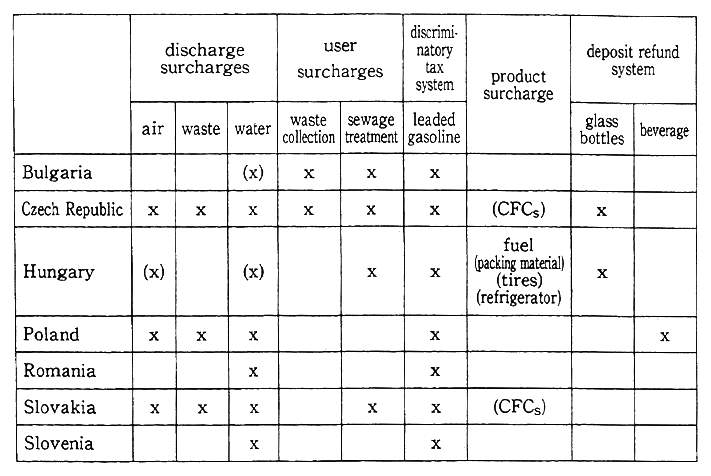
Source : United Nations data, Parentheses indicate introduction planned.
In Poland a surcharge is imposed on companies for the direct discharge of sulfur dioxide and nitrogen oxides. In the case of a viola-tion it is possible to impose a fine of ten times the surcharge.
In Hungary there is a plan to introduce a surcharge on the discharge of air pollutants on the occasion of the introduction of a new air conservation system.
(ii) Waste area
* User surcharge by local public bodies
In Bulgaria, since 1951, a surcharge has been imposed on users of waste treatment.
The calculation of the surcharge is not directly connected to the amount of waste generated, and it has become common for the income, due to the severe financial situation, to not be used just for waste management, but also for public health and education.
In the Czech Republic the user surcharge imposed on the treat-ment of waste was greatly increased in 1992. In Prague it is 14.53 ECU (1993) per ton. Because of this it is difficult to do quantitative measure-ment, but the amount of waste products have been decreased However, on the other hand, the illegal dumping of waste has increased.
* Waste treatment surcharge
Surcharges for waste treatment can be seen in the Czech Republic, Slovakia and Poland.
In Poland the purpose was to supply financial resources. In 1992 86% of the surcharge amount was paid, but in 1993 it is predicted to be about 67%.
(iii) Water conservation area
* Drainage surcharge
In the Czech. Republic, a permission system, in addition to a drainage surcharge, has been imposed on obvious alkaline and acidic substances, BOD (biochemical oxygen demand) and non-soluble sub-stances.
In Poland this system was introduced for the purpose of supplying financial resources. About half of the surcharge amount was paid from 1992 to 1993.
In Romania a sewage surcharge was introduced in 1991. In Slovakia a report was issued promoting on-site sewage treatment by companies that discharge a large quantity, due to the introduction of the drainage surcharge system. The surcharge amount is adjusted each year based on the rate of inflation.
ii. Buying and selling discharge rights
In Poland discharge rights transactions were experimentally carried out in a region and were very successful for being faster and more inexpensive than former methods, but in order to apply this more extensively it is necessary to revise the environmental law.
Table 4-3-4 Examples of the Application of Discharge Surcharges in the Countries of Eastern Europe
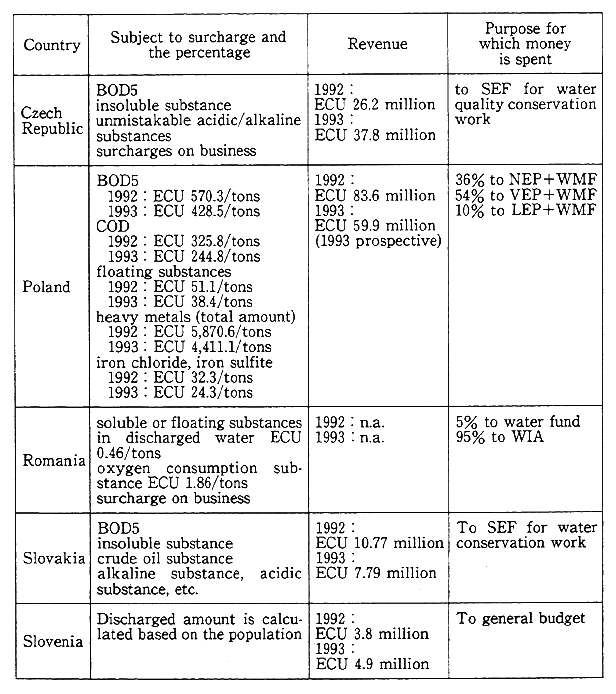
Source : United Nations data
iii. Deposit refund system
In the Czech Republic a deposit refund system applies to glass beverage containers. The recovery rate is 70-80%.
Hungary, also, has a deposit refund system for the same items.
In Poland cream bottles, beer bottles, wine bottles, plastic soft drink containers are subject to the system.
Table 4-3-5 Examples of Applications of Deposit Refund Systems in the Countries of Eastern Europe
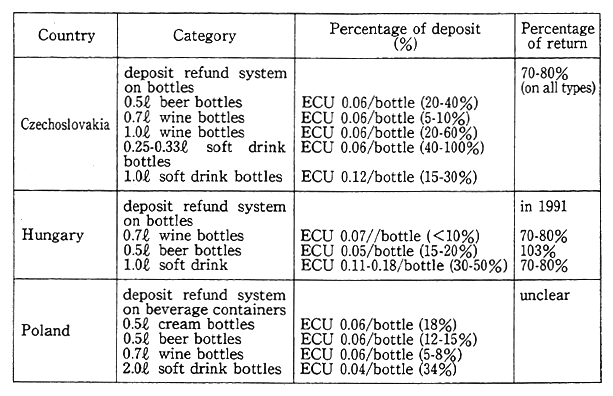
Source : United Nations data
2. Eco-business (Environment Related Industry) Trends
The amount of orders for the environment equipment industry from 1991 to 1994 are as in Figure 4-3-4. When the recent situation of the orders for environment equipment is looked at, the past peak of the amount of orders was 662.6 billion yen in 1981. After that it slumped, because of worries about the growth of private demand and public demand, but, since 1988, due to the public demand that accompanied the growth in waste, as well as the private demand, growth has continued and amounted to 1.4697 trillion yen (131.0% compared to the previous year) in 1994.
Fig. 4-3-4 Changes in the Amount of the Orders for Environmental Equipment in Japan
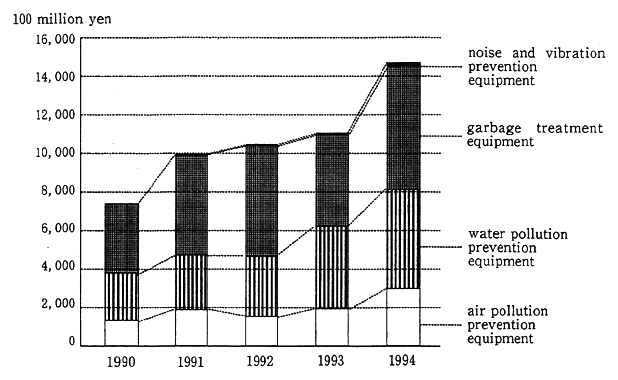
Source : Japan Society of Industrial Machinery Manufacturers
Meanwhile, the scale of the world environmental industry mar-ket, according to the OECD estimate, is said to have been 200 billion dollars in the year 1990 and will be 300 billion dollars in the year 2000. Further, according to Environmental Business International Inc., of the U. S., it was estimated to be 295 billion dollars in 1992 and is estimated to be 426 billion dollars in 1997. According to the estimate of Environ-mental Business International Inc., the growth rate and market scale, classified by industry sector, of the environment industry in the United States in 1992-1993 is as in Figure 4-3-5. When the recent one year income of each sector is looked at, the solid waste treatment, water-works and resource recovery services sector occupy the top places. And, in growth rate also, in contrast to the high growth rate of the service sector, including technology to avoid pollution in production processes, the growth rate of hazardous waste treatment and pollution prevention equipment is negative. In this way the environment industry of the United States has been forming a market centered on the service sector, and it can be said that due to this demand the growth rates among sectors differ greatly.
The eco-business of Japan, according to the 1994 survey conduct-ed by the Environment Agency, is classified into the four areas of: (1) equipment to reduce the burden on the environment, (2) manufactured products that impose a small burden on the environment, (3) services that contribute to the conservation of the environment, (4) provision for the basis of society. But, in these eco-businesses, it cannot be said that the condition of their commercialization and development, the condition of future new entrants, or research and development, have been suffi-ciently comprehended up to now. For this reason, an understanding of the state of how the eco-businesses are dealing with the situation was gained by the "Survey on Corporate Activities Amiable to the Environ-ment" (the 2,177 companies listed on all of the country's stock exchanges were surveyed, number collected 906 companies, collection rate 41.6%) which was carried out in 1994 by the Environment Agency. In the results, businesses that weren't the main business of a company were also included, and since it can be expected that among the busines-ses there are some projects that can't be announced publicly, it is not possible to comprehend the entire state of how the situation is being dealt with, but it can be regarded as something in which the position of businesses that aggressively want to publicly announce information of business activity related to the environment can be seen.
Fig. 4-3-5 The Market Scale and Growth Rate of the Environmental Industry in the United States Classified by Business Sec-tors
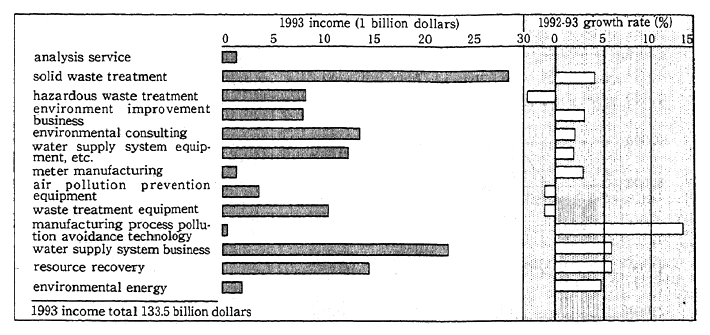
Source : Environmental Business International, Inc.
(1) State of the commercialization and development of eco-businesses
1) Equipment, etc. to reduce the burden on the environment
Among the 906 companies that responded to the survey there are 146 companies (total number of cases of companies 416) that commer-cialized and had sales (hereafter referred to as "commercialized") in this area. The number of cases that had previously been commercialized were 67 cases of water pollution prevention equipment, 55 cases of air pollution prevention equipment, 44 cases of waste treatment equipment, 34 cases of cogeneration systems, 26 cases of recycling equipment, and there were many cases of the commercialization of various kinds of pollution prevention equipment. Further, there were 96 companies that had completed development (hereafter referred to as "completed devel-opment") and there were many businesses that were developing various types of pollution prevention equipment, especially, companies conduct-ing development related to CO2 technology can be seen,including 15 cases of fuel cells and ten cases of CO2 separation technology (Figure4-3-6).
2) Manufactured products, etc. that impose a small burden on the environment
There are 154 companies (197 cases) that have commercialized with much commercialization related to saving energy, saving resources and recycling waste products, such as, 30 cases of Eco-mark products, 24 cases of recycling of used-paper, 17 cases of substitute. Freon, 16 cases of recycled plastic, 14 cases of energy saving household electrical appliances. Few companies have commercialized low polluting cars. Further, there are 77 companies (116 cases) that have completed devel-opment. Like commercialization, much development was related to conserving resources and recycling waste Especially, companies that developed low pollution cars, such as eight cases of electric cars besides six cases of natural gas cars, were able to be seen.
Fig. 4-3-6 State of the Development and Commercialization of Eco-businesses
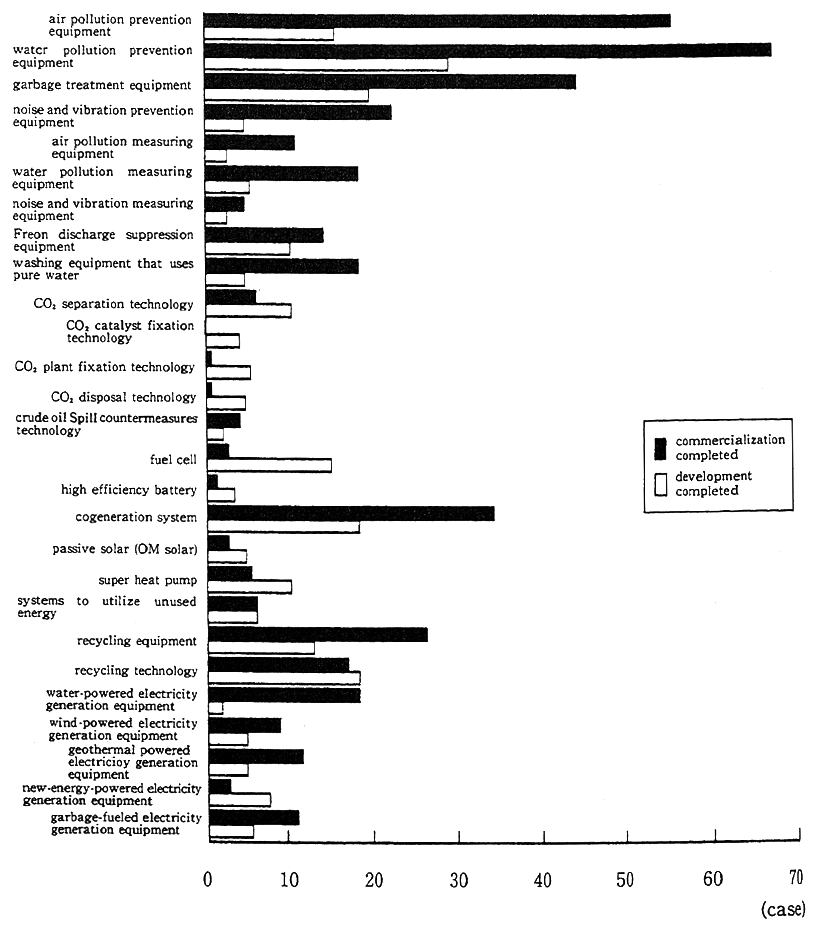
1) Development and sale of equipment, etc. to reduce the burden on the environment
Source : Environment Agency
(Fig. 4-3-6 costinued)
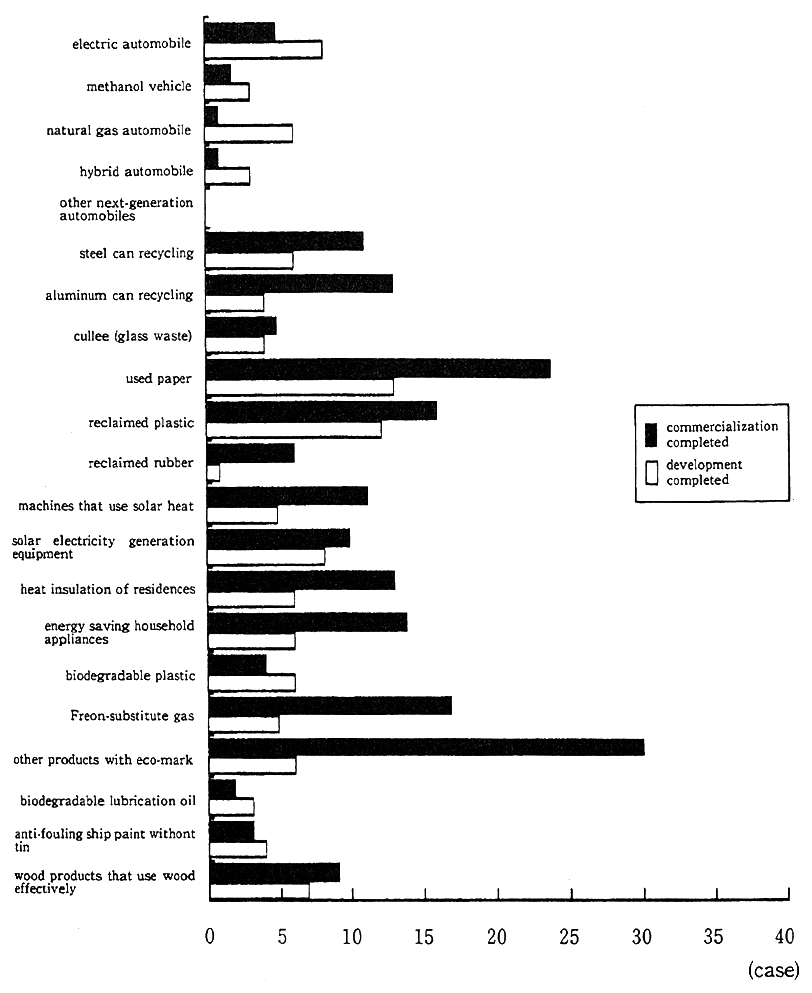
2) Development and sales of products, etc. that have less burden on the environment
Source : Environment Agency
(Fig. 4-3-6 continued)
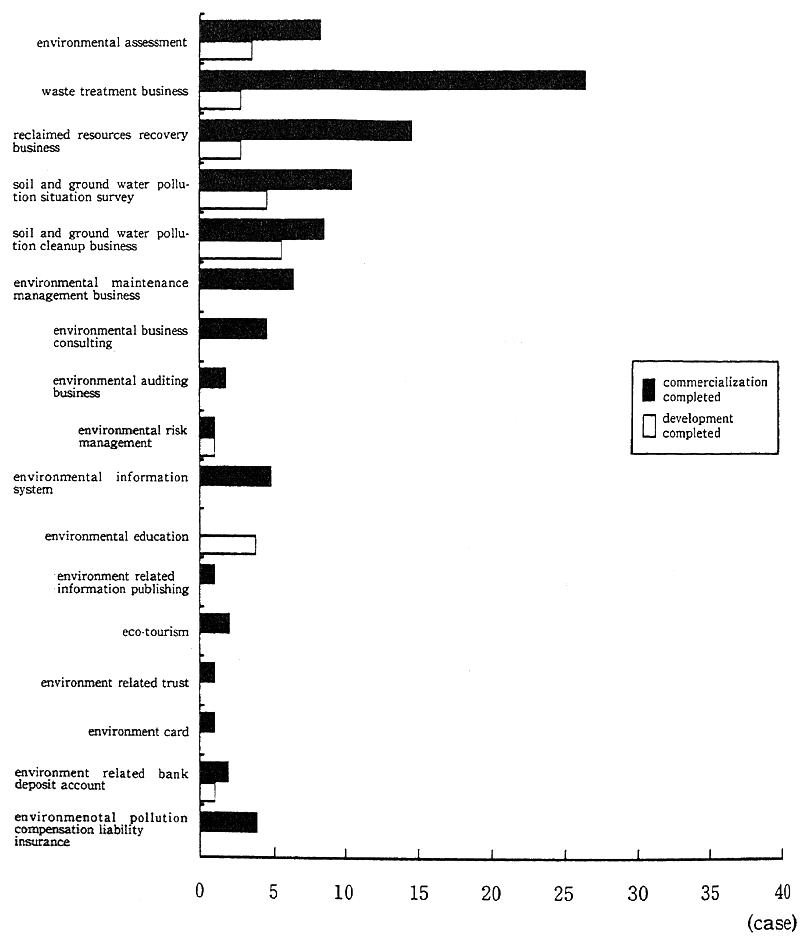
3) Development and sales of services, etc. that contribute to environmental conservation
Source : Environment Agency
(Fig. 4-3-6. continued)
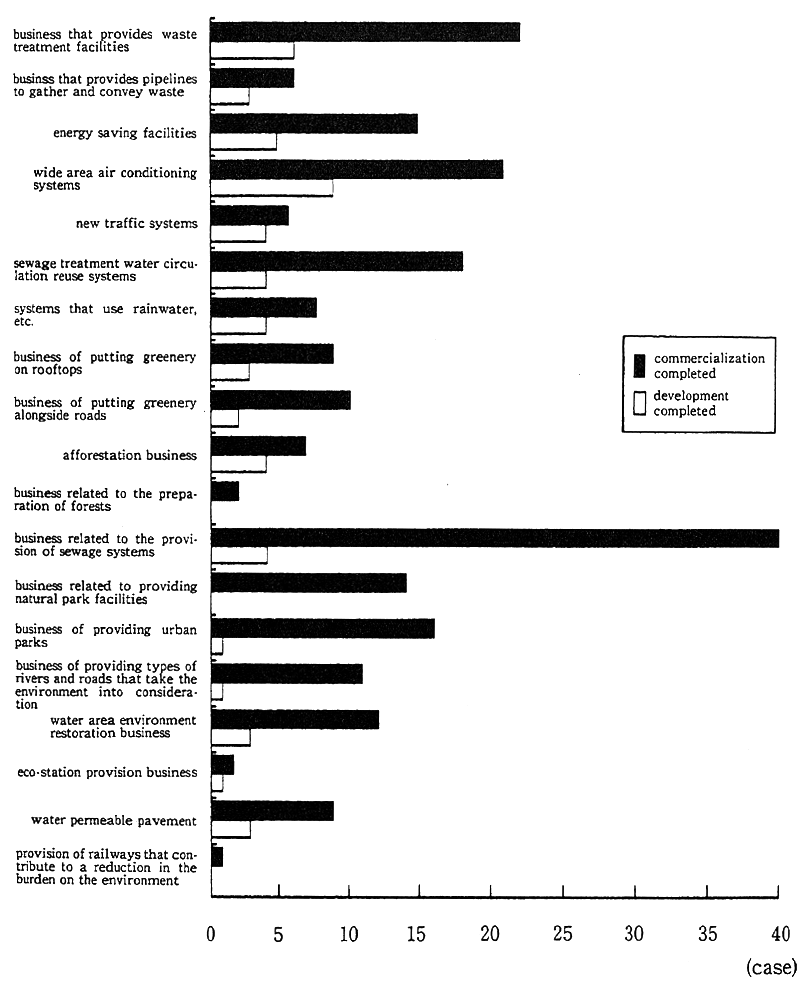
4) Development and sales of technology, instruments and systems, etc. related to infrastracture improvement
Source : Environment Agency
3) Services, etc. that contribute to the conservation of the environment
There are 62 companies (102 cases) that are commercializing, such as 27 cases of the waste treatment business, 15 cases of the recycled resource recovery business, 11 cases of the soil and ground water pollution survey business and nine cases each of the soil and ground water pollution cleanup business and the environment assess-ment business. Among these, few businesses are commercializing in such businesses as the information type eco-businesses. Further, 18 com-panies (27 cases) have completed development, such as, six cases of the soil and ground water pollution cleanup business, five cases of the soil and ground water pollution survey business and four cases each of the environment education and environment assessment businesses. There are practically no companies that have completed development in such businesses as the environment conservation management environment consultant business and information type eco-businesses. Dealing with the situation in these areas isn't very advanced.
4) Technology, equipment and systems related to provision for the infrastructure of society, etc.
There are 89 companies (229 cases) that have commercialized, such as 40 cases of businesses related to the provision of sewage systems, 22 cases of businesses providing waste treatment facilities, 21 cases of area-wide air conditioning systems, 18 cases of treated sewage water recycling systems, 16 cases of businesses that provide metropoli-tan parks and 15 cases of energy conservation facilities. Further, there are 37 businesses that have completed development (57 cases), such as nine cases of area-wide air conditioning systems, six cases of businesses providing waste treatment facilities, five cases of energy conservation facilities, four cases each of the reforestation business and businesses related to the provision of sewage systems.
(2) The state of future research and development plans or entrants to the eco-business
As for equipment, etc. that reduces the environmental loads, there are 98 companies (260 cases) that are about to deal with entering or research and development in the future, such as 46 cases of cogeneration systems, 22 cases of fuel cells, 21 cases of waste treatment equipment, 20 cases of systems for the utilization of unused energy and 18 cases of recycling technology (Figure 4-3-7).
As for products, etc. that impose a small load on the environment there are 91 companies (138 cases) that similarly are about to conduct research and development and enter in the future, such as 23 cases of recycled plastic, 19 cases of bio-degradable plastic, 12 cases of solar electricity generating equipment and ten cases of residential thermal insulation. We can see that plastic related products have, particularly, attracted attention.
Fig. 4-3-7 The Situation of Eco-businesses that will be Entered in the Future or Planned Research and Development
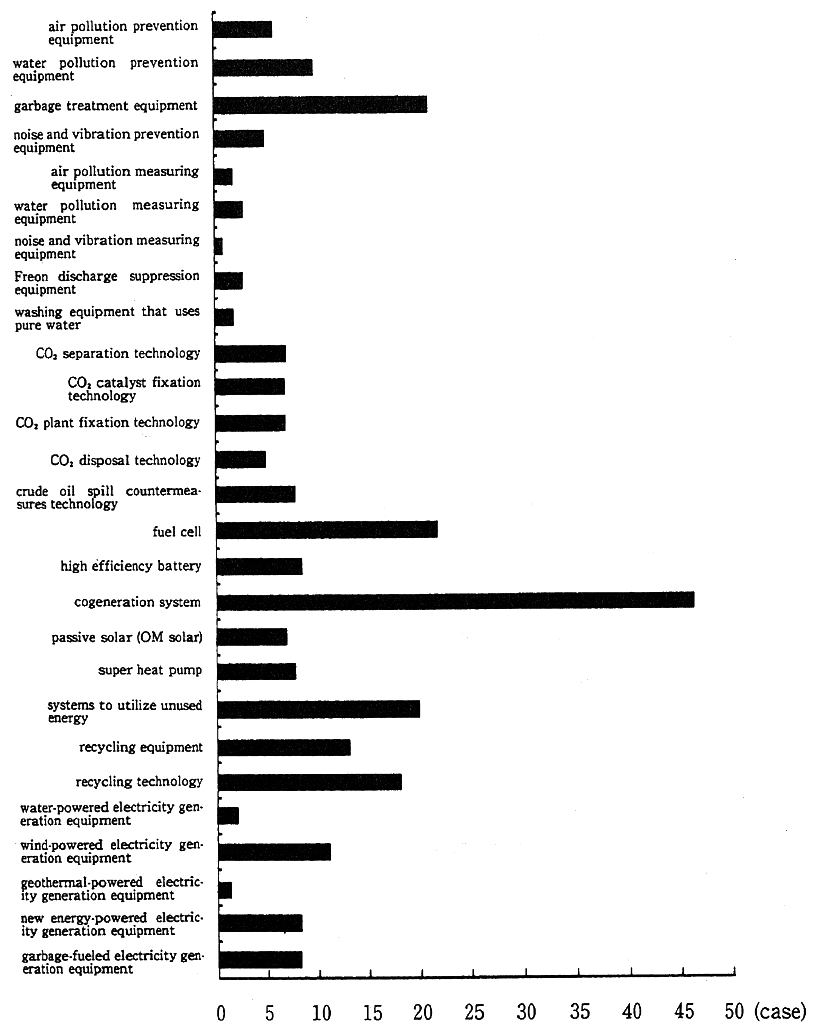
1) Development and sale of equipment, etc. to reduce the burden on
the environment
Source : Environment Agency
(Fig. 4-3-7 continued)
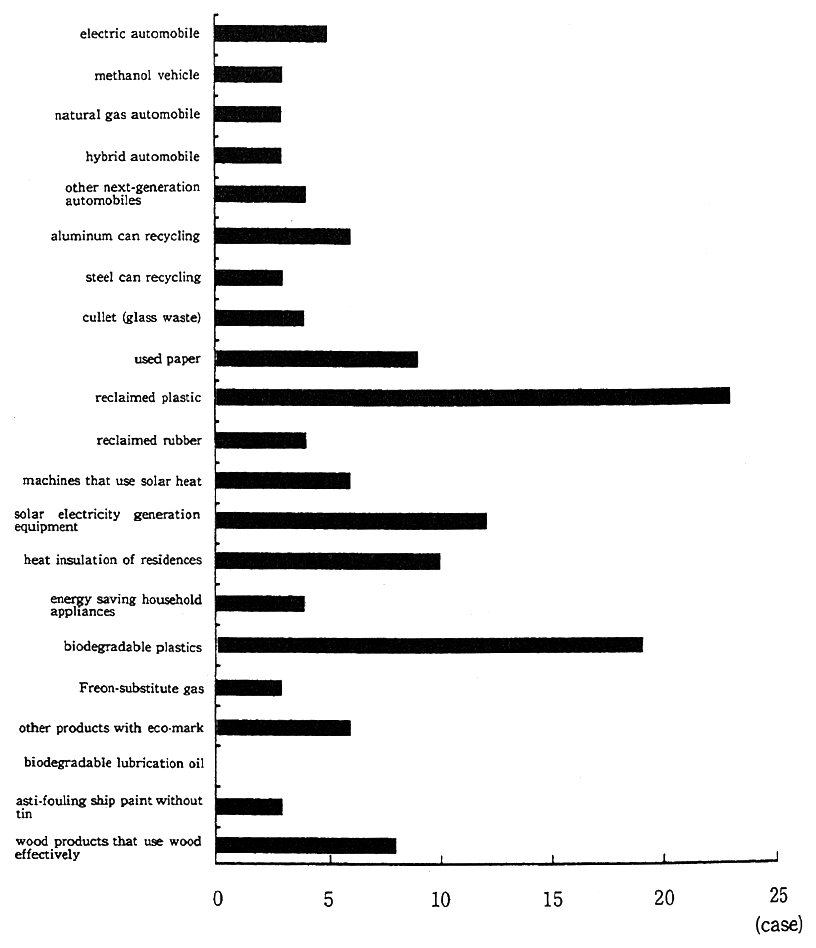
2) Development and sales of products, etc. that have less burden on the environment
Source : Environment Agency
(Fig. 4-3-7 continued)
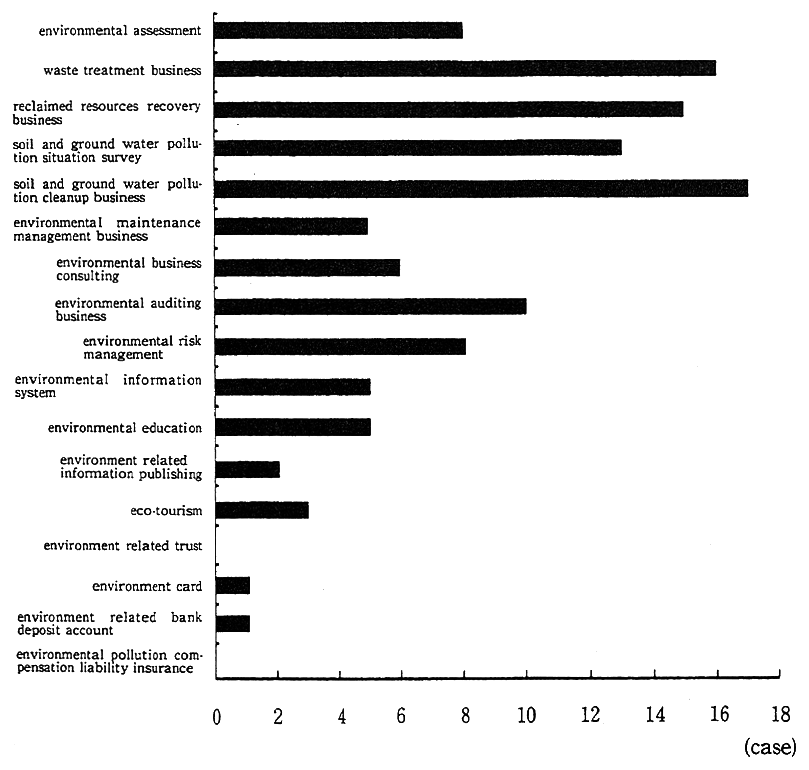
3) Development and sales of services, etc. that contribute to environmental conservation
Source : Environment Agency
(Fig. 4-3-7 continued)
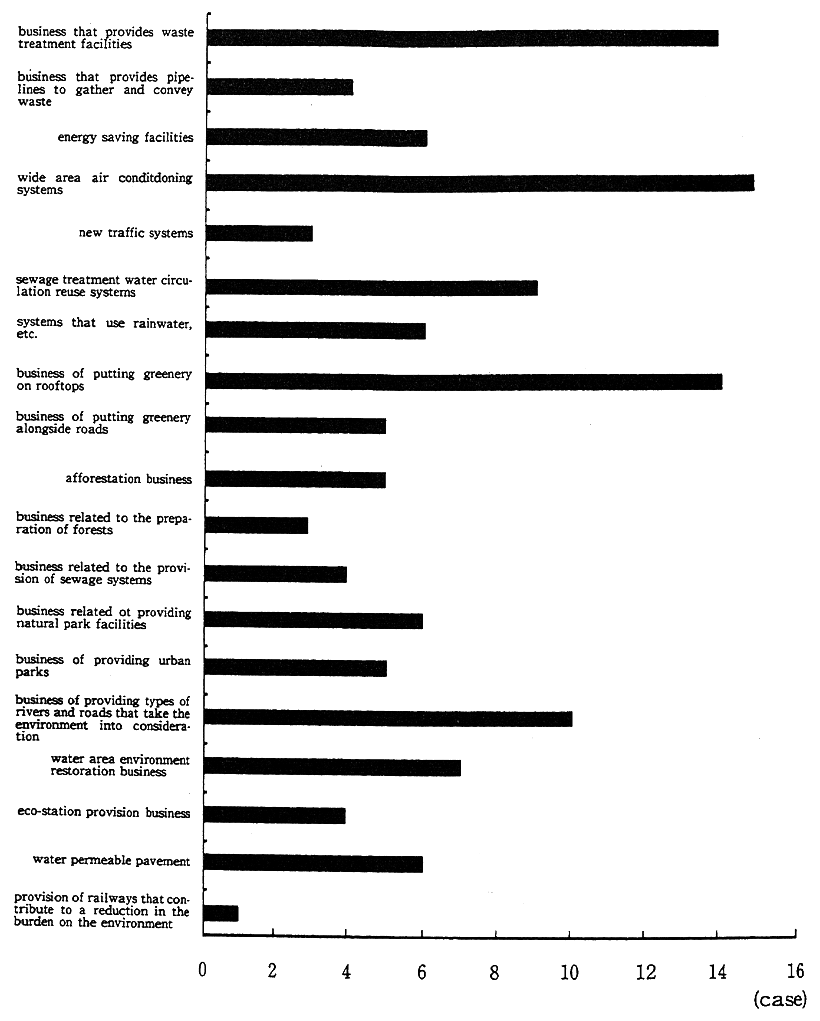
4) Development and sales of technology, instruments and systems, etc.related to infrastructure improvement
Source : Environment Agency
Similarly there are 53 companies (115 cases) in the area of services, etc., that contribute to conserving the environment that are about to conduct research and development and enter in the future, such as 117cases of the soil and ground water pollution cleanup business, 16 cases of the waste treatment business, 15 cases of the recyclable resource recovery business, 13 cases of the soil and ground water pollution survey business and ten cases of the environment inspection business. Soft-type businesses, such as the environment andit business, environment assessment, environment business consulting and environ-ment risk management can be regarded as developing from now on.
There are 61 companies (127 cases) in the area of technology, equipment and systems related to providing the basis of society that are about to conduct research and development and enter in the future, such as 15 cases of area-wide air conditioning systems, 14 cases each of businesses providing waste treatment facilities, and putting greenery on building rooftops, ten cases of businesses that provide roads and rivers that take the environment into consideration and nine cases of treated sewage water recycling systems.
In the above we have come to see the state of the commercializa-tion, and the research and development, of the eco-business, but in the case of the development of the eco-business from now on, because the market has not been established, it can be thought that there is still much anxiety about how it will evolve. In the above mentioned business attitude survey, concerning the problem points in the development of the eco-business from now on, where multiple responses were asked for, the response "consumer and user concern is still low" made up 36.2% of the total, "development costs will be great" made up 29.9%, "don't know the market scale of the various areas" made up 26.7%, "at the present scale of the market it is not suited to making a profit" made up 23.5% and "not able to sufficiently comprehend which area is promising" made up 20.1%.
In this way several problem points have been indicated in the development of the eco-business. Even if the market of the eco-business hasn't been established, businesses that are independently aggressively grappling with the situation as environmental conservation activity connected with business are carrying out various development activities in the area of eco-business. Further, commercialization is progressing and new environment related products, services and technologies are being born. For example, there are those related to unused energy, such as wave power for generating electricity, those related to recycling and reclamation, such as reclaiming Styrofoam, and other products that impose a small burden on the environment related to energy conserva-tion and resource conservation, as well as environment measurement analysis, that are opening up new areas of the eco-business.
The state of commercialization or development of the individual areas that control the market trends of the eco-business is that at present they extend over various industrial areas. Further, concerning new entrants as well as research and development from now on, accord-ing to the above mentioned survey, the total number of cases can be expected to be 640 (81 businesses of 84) and it can be regarded as something that will be further invigorated.
The eco-business is something in which aggressive businesses active in environmental conservation make businesses of environment related areas as new business opportunities. According to the prelimi-nary calculations of the Environment Agency, the scale of the eco-business market in 1990, comprehended quantitatively, was about six trillion yen, and it is predicted to be about 13 trillion yen in the year 2000, about 26 trillion yen in the year 2010, and it can also be expected to grow in the future. Further, also in the "Business Environmental Vision" of June 1994, that is the opinion report of the Global Environ-ment Subcommittee of the Industrial Structure Committee, an analysis of the scale of the present and future market of the environmental industry was carried out by area. It differed from the preliminary calculation of the Environment Agency clue to differences of methods and subjects estimated, but it predicted that the present scale of the market of about 15 trillion yen would reach about 23 trillion yen in the year 2000 and about "35 trillion yen in the year 2010. It points out that movements are evolving to rank the environment related businesses as strategic business areas that can be expected to expand from now on.
The efforts of businesses to commercialize, as well as to do research and development in, environment related areas will expand the eco-business market or create a new market. The same as other indus-tries, development of the product and services market as a business through the principle of market competition is being promoted. By being able to rank eco-businesses as one part of industrial activity, environ-mental considerations are incorporated into business activity and the environmental conservation type of industrial activity can be regarded as being promoted even more. The development of eco-businesses is an important factor in the formation of a society that is able to continue to have less impact on the environment. The growth of eco-businesses is something that is necessary to be promoted by the efforts of businesses to aggressively invest in the environment and develop technology, by appropriate government support, and by environment related informa-tion for the comprehending of trends from now on. Through eco-businesses it can be expected that the efforts of each actor directed towards environmental conservation, such as the environment-friendly consumption behavior of consumers and the environmental conserva-tion behavior of countries, as well as local public bodies, as consumers and businesses, including the environmental conservation type industrial activity of the industrial world, will be able to go forward vigorously.
Section4. Environment and Information
As seen above, the appropriate utilization of information can be regarded as an important point in heightening the effect of environmen-tal countermeasures. For this reason, at present, in addition to consider-ing the effect that the advance of the information orientation on a world scale has on the environment, we would like to investigate the utiliza-tion of environment related information and its relationship to effective environmental countermeasures.
1. The Development of the Information-orientation and the Environment
First, we would like to consider the burden on the environment due to the development of the information-orientation. In an information-oriented society it can be regarded as something that makes life more convenient in many areas, but at the same time, it can also be expected to be something that exerts a great influence on the environment (Table 4-4-1). The utilization of information communica-tion has the effect of conserving energy in various areas through the substitution and absorption of the movement of people and things, the trend towards not using paper, and by making energy consumption more precise, and can be expected to be linked to the reduction of the burden on the environment, such as a reduction in the amount of carbon dioxide discharged.
Table 4-4-1 Major Information-oriented Applicatns and Their Effect and Influence on the Environment
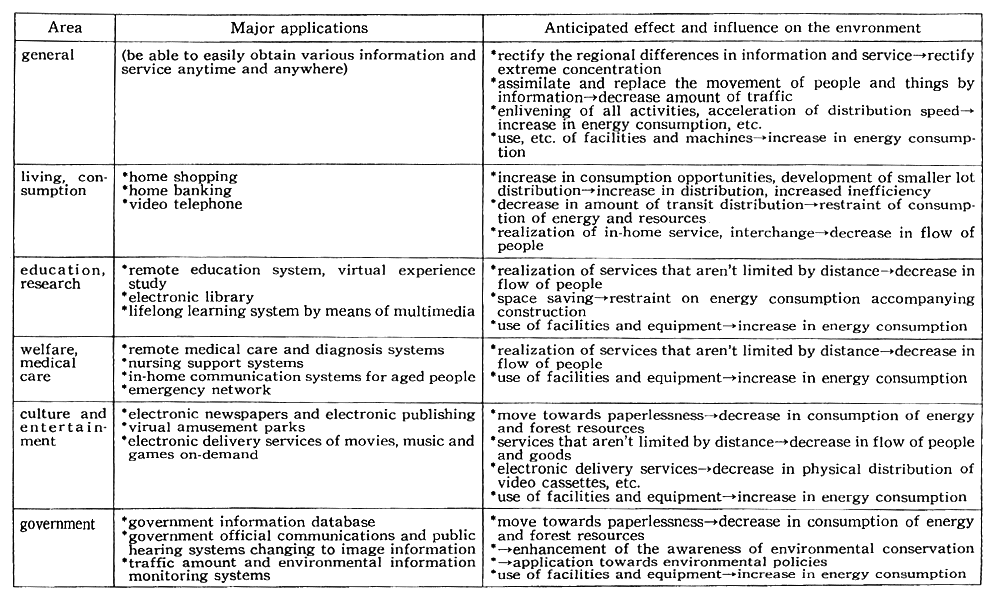
(Table 4-4-1 continued)
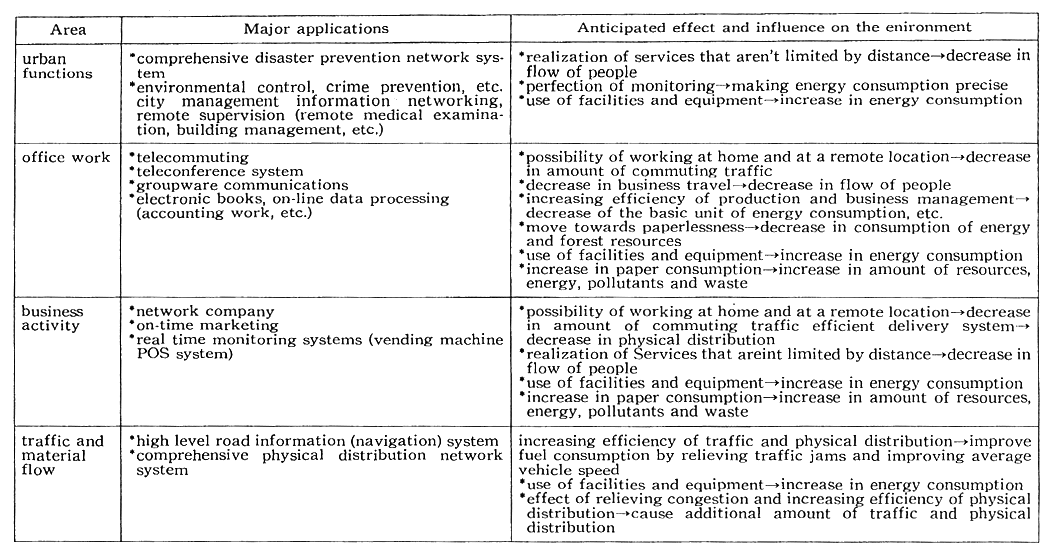
Reference : Prepared by referring to "Towards the Reform of the Intellectual Society of the 21st Century" Ministry of Posts and Telecommunications, 1994, "Research Group related to Environmental Problems and Information Communication" Ministry of Posts and Telecommunications, 1995, "Global White Paper 1994-95," etc.
On the other hand, there is also the concern that the utilization of information communication will increase the burden on the environ-ment, such as, by causing the increase in resource and energy consump-tion that goes along with the manufacture and management of informa-tion communication equipment, besides promoting the enlivening of various activities due to the creation of leisure time due to increased efficiency and motivating the activity by the presentation of informa-tion. For example, the realization of the home shopping service, on the one hand, contributed to reducing the burden on the environment because of the simplification of distribution channels, but has caused concern about the possibility of increasing the amount of the discharges of NOx and CO2 and the amount of energy consumption by increasing distances and making the distribution lots smaller. Consequently, when the relationship between information and the environment is considered, it is necessary to comprehensively consider both the positive and nega-tive effects.
To take one example, according to the preliminary calculation of the Ministry of Posts and Telecommunications related to the utilization of a teleconference system, the teleconference system, in the case of the diffusion of about 40,000 terminals, through the reduction in the number of business trips, etc., would absorb 9.1% of the average annual increase of the two year period from 1990 to 1992 of the total amount of CO2 discharged in Japan's transport sector (the amount of CO2 absorbed per terminal is 4.58 t-c/year). On the other hand, regarding the negative impact on the environment due to this system, concerning the energy consumption accompanying the use of the teleconference system, the amount of CO2 discharged was estimated (increased amount of CO2 generated per terminal 0.53 t-c/year), and the utilization of the telecon-ference system was reported to have the effect of reducing the burden on the environment. However, in this preliminary calculation it is necessary to take into consideration that sufficient preliminary calcula-tion was not done concerning the influence on the environment due to the other activity that appropriated the moving time saved by the teleconference system.
Next, let's look at an example in which the energy consumption that supports the rapid development of the information orientation has increased. For example, the electricity consumption due to computers and facsimile machines in Japan, including the air conditioning required for them, is expected to amount to more than 30 billion kwh a year. According to the electricity industry, this is about 5% of all of the electricity generated and amounts to about 22% of the total electricity consumption of the business sector. Electrical consumption by the business sector for the past ten years has consistently continued to increase and about one half of this increased portion is taken by these information related areas.
This kind of large energy consumption related to information is due to the rapid diffusion of computers, that exceeded three million units on the basis of the number of units delivered in 1993. But, actually, the electricity that runs the equipment is only part of the amount. Most of the electricity is consumed by computers that are left on, even while they are not being used, and by facsimile equipment that is waiting to receive. The U. S. Environmental Protection Agency, because of the awareness of this problem, promotes the introduction of computers and printers that are especially effective for saving energy and, in order to reduce air pollution from electricity generation plants, it started the "Energy Star Computer plan" in June 1992. Due to this, an energy saving effect can be expected of 50-75% for personal computers and 30-50% for laser printers. As of July 1994 70% of the U. S. computer manufacturers, equivalent to 210 companies, and 90% of the laser printer manufac-turers, equivalent to 31 companies, are participating in this plan.
Until now, due to the increasing expansion and intensity of socioeconomic activity, including becoming information oriented, the flows of people and things have become faster, and they have, moreover, induced each other. The goods distributed have come to move faster and become greater in scope. From now on, the environmental loads through the consumption of energy will continue to increase. As seen previously, the further development of the information orientation has the possibil-ity of reducing the environmental loads, and, as will be seen subsequent-ly, by the appropriate utilization of environment information, it can be regarded as contributing to the greater efficiency of environmental countermeasures. However, in the process of becoming oriented towards information up to now, it is also a fact that the electricity consumption of the business sector has continued to increase. From now on it is important that the orientation towards information proceeds based on a viewpoint that more aggressively reduces the burden on the environment.
2. The Preparation and Utilization of Environmental Information
(1) The utilization of environmental information to heighten the effect of environmental countermeasures
At the "International Conference on Environmental Information Facing the 21st Century" held in Canada environmental information was defined from the viewpoint of decision makers as "data and statistics and other qualitative and quantitative material necessary in order for decision makers to evaluate the state of the environment and trends, to decide and to adjust the direction of policy and to invest capital." To construct a society that is able to continuously develop while planning the development of a healthy economy that has a slight load on the environment and maintaining an abundant environment blessed with health, first it is desirable to grasp extensive information related to the environment, decide on a "environmental plan" based on these special characteristics and carry out "environmental management." Further, appropriate consideration of environmental conservation based on this kind of appropriate environmental information has become indispens-able also on the occasion of investment for urban planning and develop-ment, and is not limited to international environmental countermea-sures.
On the other hand, environmental information that has become necessary for citizens, also was centered on such pollution related observational data as the density and components of factory sewage formerly intended for a limited number of persons, but because of the revealing of the world's environmental problems and the increase in citizen consciousness of the environmental problems, extensive informa-tion, such as the influence on future generations and the environmental impact on a world scale, has come to be demanded, and information with a higher added value that has been further classified and analyzed also has come to be desired.
This information is not just indispensable for environmental administration and the execution of a plan at the regional level, by making it widely available it will respond to various needs related to environmental conservation, including contributing to the promotion of spontaneous environmental activity by citizens and private groups and become something which makes a tangible and intangible contribution to creating a better environment. If the accumulation and use of infor-mation by citizens becomes easier, it can also be expected that partici-pation in citizen activity will be promoted, lifestyles will improve and proposals to government will be stimulated.
This kind of effect corresponds to the cost required for the collection, management, supplementation, analysis and reporting of the data, and it is necessary to utilize it so that it does correspond.
Generally, since the intangible consciousness raising and educa-tional effects of information are great, measuring its benefit is essen-tially difficult.
A campaign to reduce the amount of garbage has been conducted in Tokyo since 1989. Since this campaign presented information by using posters and information papers, television and radio as well as by developing educational activity, about 1.3 billion yen (1993) was spent in Tokyo related to this. The cost of treating garbage in Tokyo is about 190 billion yen a year. Even if the cost of treatment temporarily de-creased only 1 % due to the success of this campaign to decrease the amount of garbage discharged by households, it can be regarded as an effective policy from the point of view of cost. Long-term, when the effect of a reduction in the cost of providing facilities, that is over about 80 billion yen a year, and the fact that the cost of landfill will become even higher from now on are considered together, the result of this campaign should attract attention.
Environmental information is not just an aid to environmental administration and information offered to residents as mentioned above, it has begun to attract attention for the purpose of the development of an environmental index.
Internationally, also, the specific item of an environmental index was investigated by the OECD in 1993, ultimately, for the purpose of incorporating environmental considerations into macroeconomic policy Because the item investigated here is related to environmental change, eutrophication and environmental pollution, such as, the discharge of hazardous chemicals, it has taken up many topics, such as, natural resources, such as, forest resources and water resources.
To respond to this trend it is desirable to collect and analyze the environmental information possessed by each region in a form that makes regional comparisons and international comparisons possible. Further, so that these constructed information databases are mutually accessible and will become an integrated network that is able to com-bine the data, it should be implemented based on a long-term plan. Making a network will not just make it more convenient for the users of the data, it will also be effective as a method for making the collection of information more efficient.
Further, the information providing system is completed by the handling procedures of information collection (monitoring), classifica-tion, analysis and diffusion. Consequently, in order to more effectively make the entire information system functional, it is necessary for emphasis to be placed on the points of the development of an informa-tion collection system with a small maintenance burden for creating and revising its database and the construction of an information providing system that the various bodies that deal with environmental conserva-tion can freely access. Particularly, the creation of a system that anyone can easily access is important also from the point of view of the effect. For this reason, not stopping with the devising of the system itself, the provision of "places" such as environmental information center and environmental information corner the establishment of a service that is also able to provide information off-line and publicity to raise aware-ness should be able to be expected.
(2) The present situation of the collection and diffusion of information related to the environment
In Agenda 21 adopted at the UNCED (United Nations Conference on Environment and Development) in 1992, as an item in the action plan related to "information for decision making," "eliminating data differ-ences (development of an index of development that is sustainable and the promotion of its international use)" and the "improvement of the provision of information" are mentioned. These, by promoting "develop-ment that is sustainable," reflects the awareness that it is necessary to promote the basing of decisions on various levels, from the international level to the individual level, on sufficient and accurate information.
In this way the creation of a mechanism to collect and diffuse sufficient and accurate information related to the environment is an important topic that should be dealt with by officials and people from now on and, specifically, that the preparation and expansion of an environmental database and an environmental information system is desirable.
Compiled here is the present situation of information collection and diffusion activity related to the environmental problem on the four levels of international organizations, countries, regional public bodies and private.
1) Measures of international relations
In countermeasures against global environmental problems, such as, global warming, ozone layer depletion and acid deposition, interna-tional cooperation from the government level to the grassroots level is indispensable, since they are such that an environment polluting sub-stance discharged from one country also influences other country. For this reason information related to global environmental problems should be offered so that it is possible to be effectively utilized by everyone from the governments of each country in the world to citizens. The preparation of an environment monitoring system in an interna-tional framework and the construction of an environment information database have become important topics. Further, an "information source database" so that anyone can easily obtain the environmental information collected by the various organs of the countries of the world has also become necessary.
Below let's look at some typical examples among the specific efforts that are now being made.
i. Monitoring the global environment
As a typical measure there is GEMS (Global Environment Monitoring System) that is proceeding centered on UNEP (United Nations Environment Programme). This is a monitoring plan that targets the five main areas of climate, border crossing pollution, re-cyclable resources, oceans and pollution that are said to influence health. It is composed of the individual projects shown in Table 4-4-2.
Further, there are the efforts of the world meteorological obser-vation plan and the entire world weather observation plan by the WMO (World Meteorological Organization).
Based on this existing individual monitoring, provision for the three mutually related global observation systems of GCOS (Global Climate Observation System), GOOS (Global Ocean Observation Sys-tem) and GTOS (Global Terrestrial Observation System) that are trying to comprehensively capture the global system by long-term observation is progressing centered on the ICSU (International Council of Scientific Unions) and the organizations of the United Nations. It is necessary that the data obtained by this kind of monitoring be widely provided to and utilized by the researchers and government policy decision makers of each country.
Table 4-4-2 Outline of the Global Environmental Monitoring System (GEMS)

Note : UNEP=United Nations Environment Programme, WHO = World Health Organization, UNESCO = United Nations Educational, Scientific, and Cultural Organization, WMO=World Meteorological Organization
ii. Environmental information database
As a concrete example of a global measure to make an environ-mental information database the UNEP's project GRID (Global Resource Information Database) can be mentioned. This is a database that was constructed for the purposes of integrating remote-sensing data and various data related to the environment and offering it to the policy decision makers and researchers of the world.
GRID's data in Japan is offered to research organizations that deal with global environmental problems by "GRID-Tsukuba" of the National Institute for Environmental Studies and utilized. The main data registered at GRID-Tsukuba is shown in Table 4-4-3. Further, in the Meteorological Agency's "WMO greenhouse gases world data cen-ter" the observation data of the greenhouse gases of the world is
Table 4-4-3 Main Data Registered at "GRID-Tsukuba" collected, analyzed and presented.
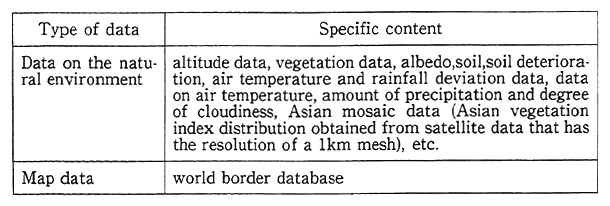
iii. Database of environmental information sources
The INFOTERRA (International Referral System for Sources of Environmental Information) managed by UNEP is typical. This is a worldwide database, registered as an organization that is able to respond to inquiries from the outside, which maintains information related to the environment. The headquarters of INFOTERRA is locat-ed in Nairobi and a representative organization is located in each participating country. In Japan the Environmental Information Center of the National Institute for Environmental Studies is registered as the representative organization. It strives to present information to research organizations within the country. In the future, in order to diffuse information to a wider spectrum of the population, providing information by utilizing personal computers and telecommunications is being investigated.
2) Japan's measures
In article 27 of the Basic Environment Law it is stipulated that the national government would make an effort to suitably offer neces-sary information related to conserving the environment, while respect-ing the rights of individuals and companies, in order to contribute to the promotion of activity related to the conservation of the environment carried out spontaneously by private organizations as well as to pro-mote education and learning related to the conservation of the environ-ment.
Based on this, the Environment Agency is starting to strengthen the information foundation necessary for promoting information presentation and environmental policies in order to promote environmental administration in local bodies and private conservation activities.
Concretely, the "Environmental Information Providing System" that provides to citizens, NGOs and local governments information related to governmental measures, the state of the environment, envi-ronmental education, information related to environmental conserva-tion activity and information on information sources related to the information provided by the system using personal computer communi-cation and facsimile communication is being developed, mainly, by the Environment Agency's environment information planning office and the Environment Information Center of the National Institute for Environ-mental Studies . Further, the increasing information orientation of governmental affairs and the support for the operation of the environ-mental information providing system have come about due to the strengthening of the information system within the Environment Agency. Further, it is attempting to diffuse the information included in the Environment White Paper by using various media such as audio, comic books and electronic media, such as, CD-ROM.
3) Measures of local public bodies
In order for local public bodies to be able to grasp, in detail, information related to the natural environment and the living environ-ment of the regional environment, it is required that it be appropriately reflected in environmental policy. Further, it is important that local public bodies make an effort to actively give residents information related to the regional environment, in order to develop more effective environmental conservation policies in cooperation with the environ-mental conservation activities of the resident's bodies that have recently become popular.
Movements promoting environmental information management, such as, the construction of the environmental information system, can be seen against this kind of background. For example, as shown in Table 4-4-4, the recent budget related to environmental information management in the urban and rural prefectures, although a small amount, is generally increasing at a high growth rate of over 10% a year when the entire budget is looked at.
The environmental information system that local public bodies should have can be divided into the types shown in Figure 4-4-1 classified by content and form.
Table 4-4-4 Changes in Budget Related to Environmental Information Management of Local Government
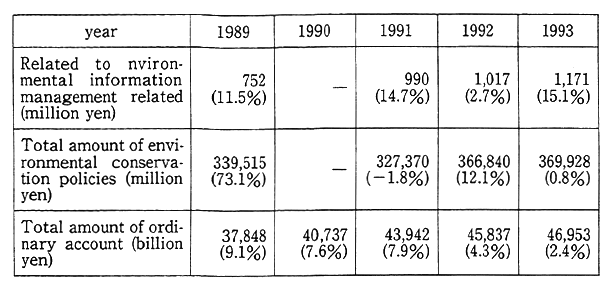
Note : Figure in parentheses is the growth rate compared to the previous year. However, concerning the environmental information management related expenses and the total amount for environmental conservation policies, because there is no data for 1990, 1993 shows the average growth rate for the past two years.
Fig. 4-4-1 Types of Environmental Information System Related to Regional Environment
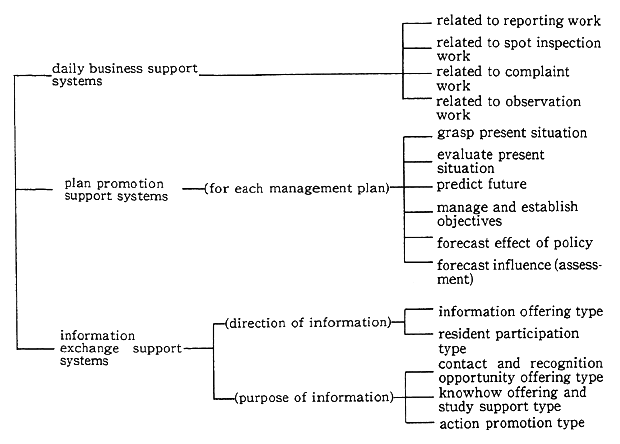
Source : "Environmental Information Systems of Local Governments"
Environmental Information Network System Research Group
The "daily business support system" information system man-ages information related to the daily business of regional environmental administration, such as, the management of complaints and reports of facilities that exert an influence on the regional environment.
The "plan promotion support system" manages and analyzes information in order to evaluate the impact of policies and management, to set targets, to grasp the present condition of the environment in a form that goes along with the objectives of a plan in order to perform the individual environmental planning of the region.
The "information exchange support system" promotes the exchange of information among various bodies related to environmental conservation. If viewed classified by form, they can be regarded as the "information offering type" that offers to citizens, in a one-way manner, information collected and managed by a public body, and the "citizen participation type" based on a two-way flow of information in order to also utilize information offered by citizens. Since cooperation with the environmental conservation activity of the citizen bodies that have recently become popular can be regarded as advantageous for regional environmental administration, from now on, it is necessary to promote the construction and expansion of "citizen participation type" informa-tion systems, especially, among the information exchange support sys-tems. With regard to this point, there is the view image management system that carries out a simulation related to the view of a city after redevelopment that has been developed by the National Institute for Environmental Studies. To actually show many redevelopment plans can require a large amount of money, but by utilizing this system, it is possible for citizens to understand more concretely and effectively and also by utilizing this system policies can be promoted efficiently.
As a concrete example of an environmental information system in a local public body let's look at the example of the city of Yokohama.
In the city of Yokohama, an environmental information system was provided in 1987 as the support system of the "Yokohama city environmental control program" decided on in 1986. This environmental control program set forth a guide to environmental considerations aimed at the realization of a good metropolitan environment that could provide a safe and comfortable life for citizens. Centering on an environ-mental characteristics chart created when this plan was decided upon, and its foundation chart, information related to laws, ordinances, land use, city facilities and the environment of Yokohama, such as, biological distribution, was recorded and put into a database, and an environmental information system was constructed to be utilized in evaluating and analyzing environmental characteristics. As of the end of 1993 the data shown in Figure 4-4-2 had been recorded. This environmental informa-tion system has the special characteristic of being composed of 18 subsystems, such as, the "environmental characteristics chart use sub-system" and the "laws and regulations search subsystem," out of consid-eration for making it easier for users to use. At present it is still in the early stages and is mostly used inside the government, but from now on, with the further improvement of the system, active use by citizens can be expected.
4) Measures of private sector
In order to promote comprehensive and effective environmental conservation measures, as seen up to now, in addition to governmental measures, information exchange on a private level is also important and active measures are increasing.
While the 1992 UNCED (United Nations Conference on Environ-ment and Development) was being held, in the same city of Rio de Janeiro in Brazil, as many as 7,500 NGOs (non-governmental organiza-tions) from 165 countries participated in a "Global Forum" and actively exchanged information about environmental problems-Taking this opportunity, environmental conservation activity on a private level acquired cooperation on a worldwide scale and from now on further more effective activity and development can be expected.
This kind of citizen cooperation on a worldwide scale can be expected to develop further with the utilization of advanced information communication. For example, in the "GLOBE" plan advocated by Vice-President Gore of the United States, the construction of an infor-mation communication network connecting teachers and students of schools of every country in the world and the joint observation of the natural phenomena of climate and regions is planned. This is the construction of an information network by national leadership, but it attracts attention as an effort in which the main actors are ordinary citizens, such as, the teachers and students of schools.
Fig. 4-4-2 Environmental Information System Data List
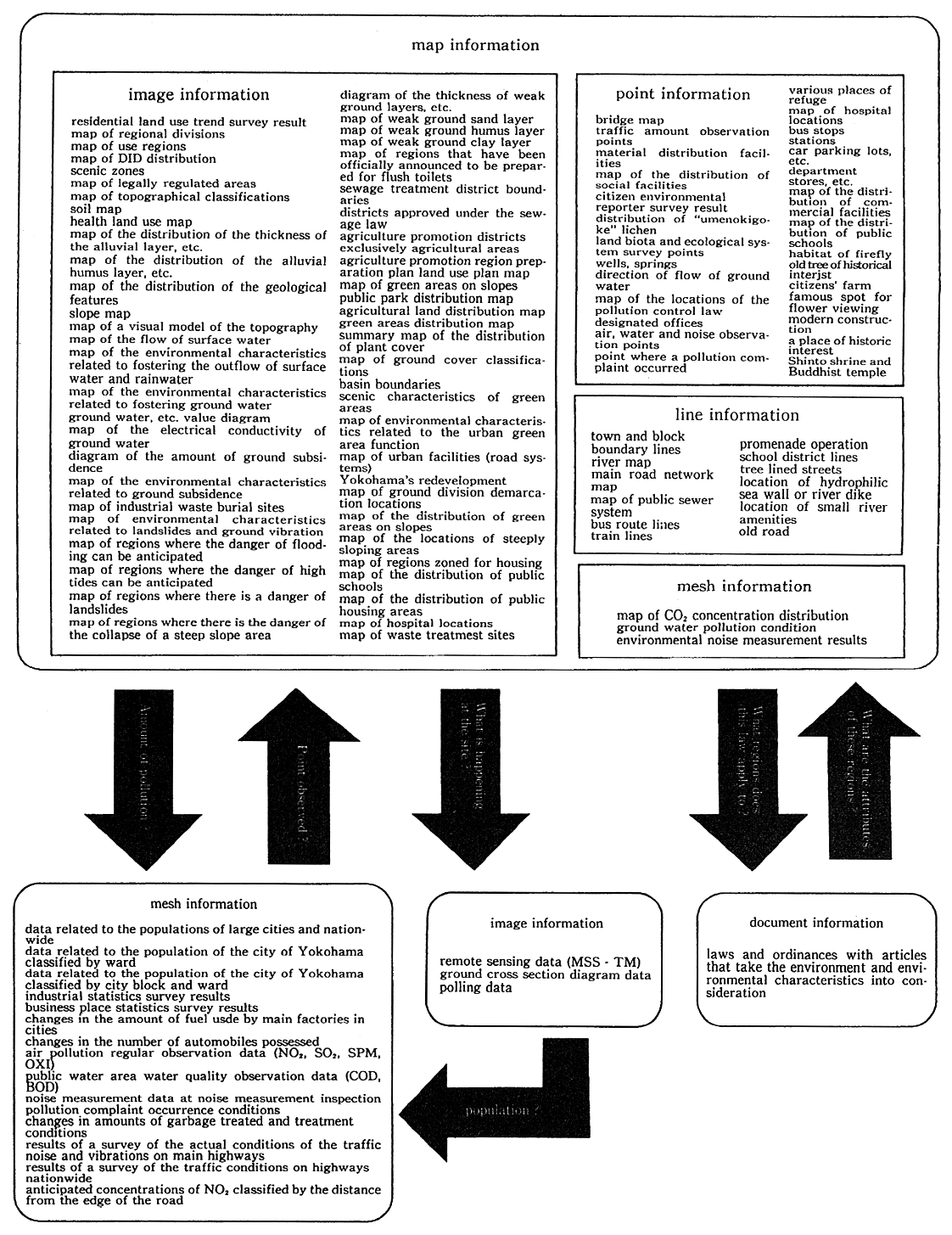
Further, also in business, movements to deal with the offering and diffusion of information related to the environment can be seen. For example, one large electronic products manufacturer has begun to offer its data related to technology related to the environment, such as, the removal of Freon, by means of the worldwide computer network, the "Internet." In addition to increasing the awareness of its company in the area of the environment, it is able to promote the invigoration of technology exchange with other research organizations and businesses and can be regarded as having great merit. Besides this, efforts at a business level, such as, offering environment related information to persons on-line, and the provision of environmental problem information by investment information companies in the United States to help people make investment decisions, are becoming active. Further, recent-ly, the introduction of large screen movies in science buildings has progressed, and the invigoration of the creation of excellent films related to environmental conservation has also attracted attention.
(3) Future topics
1) Future topics related to information and global environmental problems
As future topics for information related to the global environ-ment, the following can be mentioned in particular.
i. The promotion of information distribution, and observation
and measurement, based on unified standards
With the present situation of diverse standards of observation and measurement methods in each country it is not possible to compare the situation by each country and it is difficult to start effective counter-measures. In the future in order for each country to be able to carry out observation and measurement based on a unified standard, to compara-tively analyze the results to elucidate environmental change on a worldwide scale and to study effective environmental countermeasures, efforts should be made to decide on standards and to promote the distribution of data.
ii. Strengthening of global monitoring of the environment
Measures are progressing even at the present time, but it is difficult to say that this observation network has been sufficiently set up. In the future in order to obtain the optimum amount of information related to the global environment, in addition to completing the observa-tion network, it is necessary to make efforts to improve observation accuracy at each observation point.
iii. Support of developing countries (setting up the environmental monitoring system)
In the developing countries that have a great influence on the trends of global environmental problems the setting up of the global environmental observation system that is indispensable to the perfor-mance of appropriate environmental management is delayed. It is required that advanced industrialized countries first expand the global environmental monitoring system in their own countries, but in order to promote effective global environmental conservation policies it is neces-sary that attention be given also to the completion of environmental monitoring in developing countries. Support for setting up the environ-mental monitoring systems of developing countries can be said to be a topic that developed countries should aggressively deal with from now on.
2) Future questions related to information and global environmental problems
As future questions about information related to global environ-mental problems, the following can be mentioned in particular.
i. Promotion of the construction of the environmental information system
As mentioned above, the provision of a full-scale environmental information system in many local public bodies, although the kind of environmental information system has already constructed by several local public bodies, is a question for the future. From now on, the construction of an environmental information system in order to realize more effective environmental conservation policies for the conservation of the natural environment being lost due to urban development, and, also, for the creation of a comfortable living environment, is required of all local public bodies.
ii. Promotion of two-way distribution of environmental information
It is especially important to construct a citizen participation type of environmental information system in which it is easy for citizens to obtain information held by the government and, moreover, in which it is easy for the government to receive information offered by citizens in order to promote the active participation of citizens in environmental conservation policies. For this reason, a plan is required to offer appeal-ing information visually in a way that has been used by multimedia and in the personal computer communication that has become strikingly diffused recently. Further, besides this, it is necessary to pay attention also to the diffusion of environmental information that does not depend upon information equipment, such as, the positive handling of environ-mental conservation related articles in publicity magazines, the holding of events for the purpose of enhancing the consciousness of environmen-tal conservation among citizens and the provision of places, such as, environmental information centers and environmental information cor-ners.
iii. Other questions related to information and the environment
It is desirable that the accumulated data, without regard to the distinction between the global environment and the regional environ-ment is understood by all levels of people and become the basic material for the making of decisions. It is necessary to make efforts so that it is possible to offer environmental information in a form that is easier for ordinary citizens to understand, such as, by creating an index to make comparisons by country and by city possible, and by rapidly carrying out the appropriate collection and processing of data.
Section5. New Measures of Local Governments, Consumers and Businesses and Their Cooperation
The seriousness of the recent environmental problems has rea-ched the point of threatening the foundation of human existence and the awareness of nations, local public bodies, businesses and citizens is deepening. In order to overcome these kinds of serious environmental problems, agreement has been reached that it is necessary to construct a sustainable society while developing a healthy economy that imposes a small load on the environment and reforming the present economic and social systems and ways of life with each group bearing its fair share of the burden. This has also come to be emphasized as environ-mental ethics for human beings that live in a global environment that has limits.
Along with this kind of awareness cooperation among each group and the various actions of people is spreading. Among diverse socioeconomic activity it is extremely important that each group under-stands the role that should be taken related to environmental conserva-tion, as well as the significance possessed by actions related to environ-mental conservation, and, while mutually collaborating and cooperating under a fair allotment of roles corresponding to their respective posi-tions, act independently and positively to increase the effectiveness of environmental countermeasures.
The role of the nation, as well as those of the local governments, businesses, citizens and citizen groups that can be expected in order to realize this kind of participatory society are set forth in the Basic Environment Plan. But it is necessary that the apportionment of the roles of each body in independent and positive measures be fair and respond to the respective standpoints of the loads imposed on the environment, the benefit obtained from the environment, as well as the ability to be able to contribute to environmental conservation.
The following section introduces the state of the spreading coop-eration and collaboration among each body and the efforts related to environmental conservation due to the various activities of individuals, including the present situation of recent new measures.
1. Measures of Local Governments
For a long time local governments have played an important role in efforts to conserve the natural environment and in dealing with pollution problems, but, recently, corresponding to the spread of envi-ronmental problems, their role in regional environmental conservation has come to be expected with the objective of creating a sustainable society. For this purpose diverse policies are expected to be comprehen-sively developed in a region, while cooperating and collaborating with the nation, businesses and residents, independently and actively deciding on policies corresponding to those of the nation and other independent policies, proposing and deciding the purpose and course of measures, establishing various systems, creating the foundation of the provision of social capital and promoting the activity of each body corresponding to the natural and social conditions of the region.
(1) Enacting basic environmental decree and promoting a regional environmental plan
In local governments, movements can be seen to investigate and enact basic environmental laws from the standpoint of planning to comprehensively conserve the environment of the global environment and the natural environment taken broadly. For example, in July 1994 Tokyo enacted a "basic environmental decree" and, further, in March 1995 Mie prefecture enacted a "basic environmental decree." These decrees, in addition to the pollution prevention and environmental conservation stipulated in former laws, actively aimed at the creation of a comfortable environment and, moreover, set forth the role and pol-icies of government related to global environmental conservation and tried to clarify the course of action and policies that should be devised. Further, an "environmental comprehensive plan" and "environmental conservation basic plan" have also been drawn up for this promotion.
One characteristic of Japan's environmental administration is the deciding on, and the promotion of, each type of regional environmental plan, corresponding to regional characteristics and target areas, on the regional level, but amid today's environmental problems that have expanded from regional environmental problems to a global scale, new environmental plans for the purpose of comprehensively and systemat-ically strengthening and promoting interrelated policies are being decid-ed on. Until now regional environmental plans have been decided to respond to the actual conditions in the region, such as, the state of the regional environment, the socioeconomic conditions and the relationship between the government and residents. Various forms of plans were decided upon depending on the purposes and background the plan made necessary (Table 4-5-1).
The scope of the environment that was subject to regional envi-ronmental plans, originally, was mainly the natural environment and seven types of pollution, but gradually, expansion can be seen towards such problems of the living environment as, air pollution, radio wave interference, the obstruction of sunshine, etc., and views, as well as landmarks, historical and cultural resources, and furthermore, recently the global environmental problems of global warming, the depletion of the ozone layer, acid deposition, ocean pollution, the depletion of the forests, such as tropical forests, the depletion of wildlife, and waste products, the heat island phenomenon, the circulation of water and energy, etc. in cities and multiple and diverse chemical substances problems.
Table 4-5-1 Regional Environmental Plans in Local Governments
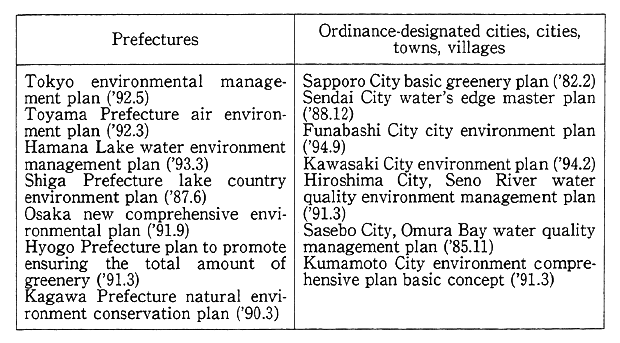
Note: Figure in parentheses is the year and month the plan was decided upon.
Source: Environment Agency.
(2) Adoption of the Local Agenda 21
Among local governments, recently, adoption of a Local Agenda 21 has also become an issue. Local Agenda 21 was advocated in Agenda 21 adopted by the United Nations Conference on Environment and Development (UNCED) held in 1992. In Japan, its passage has been progressing among prefectures beginning with the passage of "Agenda 21 Kanagawa" by Kanagawa Prefecture in February 1993. Further, in municipalities, also, measures, such as "Agenda 21 Itabashi" passed by Itabashi Ward in Tokyo in March 1994, are making progress.
Local Agenda 21 is being passed as a local government action plan for bringing about the sustainable development that Agenda 21 aims at. Even though the environmental problems that are occurring are on a global scale their causes and solutions directly affect each individ-ual person, and the understanding that measures rooted in the local governments are important for the realization of sustainable develop-ment has come to be recognized internationally. For this reason, in Japan's local governments, especially municipalities, have a close con-nection with the citizens, independent policy making can be expected to make advances from now on.
(3) Taking the initiative in environmental conservation activity
Measures to take the initiative related to environmental conser-vation as businesses and consumers are being carried out by local governments. According to the survey of 348 local governments conduct-ed by the Environment Agency in November 1994, the state of the measures was that 88.5% "consideration for environmental conserva-tion restraining the amount of energy use, in garbage separation and other governmental business related matters," 85.3% "consideration for environmental conservation dealing with the purchase and use of assets and services," 81.6% "consideration for environmental conservation dealing with the construction, management, etc. of buildings" and 60.3% were for "the implementation of staff training generally related to environmental conservation."
Examples of this kind of local public body measure, are such as Kanagawa Prefecture promoting the all-agency eco-office movement, Kumamoto city creating a handbook for environmental conservation and enhancing environmental awareness of all the staff, Kawasaki city implementing the reduction of the NOx of vehicles for public use and automobile pollution countermeasures, such as, saving energy can be seen.
(4) Degree of international environmental cooperation
According to the survey of global environmental conservation measures in the year 1993 by local governments (of prefectures and ordinance-designated cities) conducted by the Environment Agency, the total number of local governments that have implemented policies in the area of international environmental cooperation amounted to 83 bodies and 122 cases. Compared to the 72 bodies and 93 cases of the previous year this was a great increase, and the international environmental cooperation of local governments is becoming more active year by year.
Improvement of the effectiveness of international cooperation related to global environmental conservation and promotion of coopera-tion in all activities that benefit society, by businesses and the grass-roots activities of private bodies, and the cooperation activated by views related to environmental conservation cultivated by local govern-ments, have become necessary. Among these, beginning with coopera-tion through the frameworks of such international municipality cooper-ation bodies as friendship city or sister-city programs, the independent measures of local governments to promote international cooperation have become important. According to the above mentioned survey there is much environmental cooperation in the Asian region. Dispatching of personnel to developing countries and receiving trainees from develop-ing countries is being done. Outside of the Asian region, Kyoto city's dispatching of staff to Nigeria and Chiba prefecture's acceptance of trainees from Brazil can be mentioned.
In this way, in local governments there has been a grouping for direct collaboration with local governments of various foreign countries and international cooperation in the area of environmental conservation has been actively developing. In the International Environmental Munic-ipality Council (ICLEI), an international organization for the purpose of local governments that are dealing with global environmental problems, 15 bodies (as of September 1994) from Japan are participating.
The role of local governments in Europe and in the United States has come to be taken seriously. In the "European Municipality Charter for a Sustainable Society" adopted in Denmark in May 1994 it was stated that municipalities are the basis of the nation and society and that they are the smallest unit in the sustainable solutions to problems. Further, activities of the economic method of taxes and surcharges at the local level have come to be discussed at the international level. And, even among developing countries, the number of countries that recog-nize the importance of environmental countermeasures at the local level is increasing. In the future the number of requests for environmental cooperation from the municipalities of developing countries made to Japan's local governments can be expected to increase.
2. Measures of Consumers and Private Groups
Among consumers and private groups, the awareness of the necessity of improving the mass consumption and mass disposal life-style, and the consciousness of the problems of the loads on the environ-ment originating in their own lives, are deepening with respect to citizens. Due to this kind of awareness, by means of cooperation in separated garbage collections for recycling, by the reduction of garbage, by household discharge countermeasures, such as the proper use of cleaning agents, by saving energy by conserving electricity, by the selection of services and products with a small impact on the environ-ment, such as recycled paper, efforts are progressing to reduce the burden on the environment that go along with daily life (Figure 4-5-1).
Fig. 4-5-1 Changes in the Rate of Use and the Rate of Recovery of Used Paper
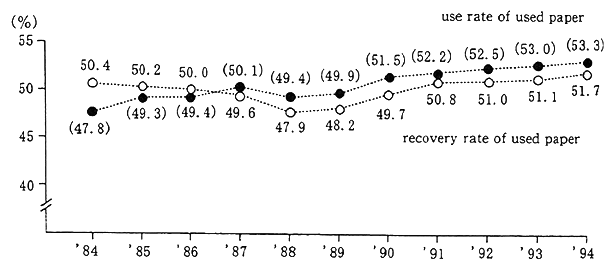
Reference: Paper and Pulp Statistical Monthly Report, Japanese Trade Monthly List
Source: Waste Paper Recycling Promotion Center
Further, regional environmental conservation is spreading stead-ily due to participation in regional recycling movements; the national trust movement ; the afforestation movement and the movement to beautify the environment; and movements to conserve water environ-ment in neibhborhood. Participation in measures for global environmen-tal conservation by means of international activities through the sup-port given to the activities of private groups is also advancing. Further, movement can also be seen of efforts by people to educate themselves, such as by actively experiencing nature in order to deepen their under-standing of the relationship between people and the environment. In addition to deepening a broad understanding of the influence the envi-ronment exerts on people's lives and the workings of nature; the way people and the environment are related as well as their history and culture: cultivating a feeling that the environment is important and a sensitivity to nature, not simply by conveying knowledge, but through experiences of contact with nature, has become necessary.
(1) The state of participation in environmental conservation activity
The consciousness of trying to start some movement concerning the environment, or of trying to expand activities even though one has already participated in a movement, supports positive citizen movement and can be regarded as promoters of still more active measures. In the "Public opinion survey related to consumer problems" by the Prime Minister's Office in December 1994, as information that people would like to have related to their lives as consumers, "information related to the safety or dangerousness of a product (additives, quality, materials, use, etc.)" (53.0%) and "information about product testing and a compar-ison survey of products and service, etc." (31.7%) were mentioned. In addition, "information about environmental conservation and environ-mental problems, such as recycling" (20.2%) was also mentioned. Measures that are spreading due to this kind of consciousness of participating in environmental conservation movements as citizens and consumers are seen in the following.
Movements being carried out to bring people into contact with the environment start as movements to observe towns, people and nature in order for people to discover the close relationship between man, nature, their own lives and those of surrounding people. As exam-ples of these, country walks through farming villages for the purpose of coming into contact with nature and the people of the farming village, and nature games in which people experience nature and the environ-ment while enjoying games enabling them to deepen their understand-ing, can be mentioned.
PLT (Project Learning Tree), progressing in the United States with the support of the American Forest Foundation and the Western Regional Environmental Education Conference, enables children to understand the state of the environment and resource protection. It is comprehensive environmental educational material so children can learn how to think, not learn what to think, about the environment. The network of this activity includes teachers, businesses and persons in charge of environmental administration. Over 20 million elementary and middle school students in such countries as the United States, Brazil, Finland, Sweden and Canada use PLT. PLT is also being started in Japan.
Further, it goes without saying that care must be taken concern-ing the protection of nature when dealing with the collecting of wild edible plants and herbs, such as the protection of new sprouts and the prevention of indiscriminate collecting. But, through the action called eating, one becomes aware of living with nature, and activities that are able to consider a review of lifestyle and daily eating habits are being conducted, as are an outdoor activity called backpacking in which people move by themselves through nature burdened with all of the shelter, food and clothing that they require, and an activity that is able to be seen in Germany, called Kleingarten, in which the creation of city resident farms aims to enable people to come into contact with the nature of farming villages through the production of agricultural prod-ucts.
In nature observation, the sanctuary activity, for the purpose of protecting the living environment of wild birds; animal watching, in which wild animals are observed in the mountains; and snorkeling, in which the nature and the life in the ocean are observed, can be mentioned. But surveys of water quality, which investigate the pollution in nearby rivers and ponds, surveys of acid deposition on a national level, and surveys of stars connected to understanding the environmen-tal problems of atmospheric pollution, are also conducted by citizens.
Further, activities are being carried out from the viewpoint of the "soundscape" (landscape of sound), regarding the sound environment as the sound that is produced as a result of the operation of people and nature taken as one scene. For example, sound walks are conducted in which people walk while straining their ears to search for the sounds of the natural world, such as the murmur of trees, the sounds of birds, the sounds of people talking, the sounds of various other activities, and the sounds that are connected with a person's memory in the area.
In the state of participation in the activities in a region, besides the recycling activity of old cloth, old paper and used bottles, the cleanup activities to pick up trash scattered in towns, rivers and in the coast; activities to conserve and restore the biotope (living area of an organism) on a citizen level ; activities to revitalize and enliven rivers for the protection of clear and beautiful rivers; the conservation and management of the thicket of mountain villages ; the creation of agri- cultural and mountain village eco-museums ; water's edge environment conservation activity with respect to spring water and the reduction of greenery; and activity to conserve the environment where fireflies live can be mentioned. Another important activity is the national trust activity that buys familiar natural areas and cooperates in environmen- tal conservation.
In the 1993 Environment Agency monitor questionnaire, persons that replied "I would like to try to participate in the environmental problems of developing countries amounted to 49.9%. Of them, the details of how they wanted to cooperate were, "cooperate with an official foundation or system, such as the global environmental founda- tion" 61.3% and "cooperate with a volunteer activity and domestic NGO in order to improve the environment of a developing country" 58.2%. Concerning this kind of participation in NGOs and volunteer activity in order to improve the environment of developing countries, participation in nature protection activity, such as the creation of nature protection zones in developing countries and protecting animals that are on the brink of extinction worldwide ; development education that considers the environment and development within a country; and activity to protect tropical forests to learn about the relationship between the destruction of tropical forests and one's own life are being conducted.
Further, overseas cooperation activity, such as constructing a network, within and outside the country, with the NGOs of developing countries and offering information concerning the citizen's bodies that are carrying out activity to collect the opinions of elementary and middle school students and communicate them to many people, includ-ing leaders in every field and the heads of the country in the world; activity for afforestation of the mangroves, etc. in developing coun-tries; and tropical forest protection, are being carried out. With respect to other environment related networks, the creation of a personal computer communication network specializing in environmental prob-lems as an NGO-information, and the creation of a network of environ-mental education activity are also taking place. Further, besides the measures of citizen groups that carry out activity such as the policy proposals by NGO, the holding of symposiums for citizens and the nationwide support for citizen activity, "campus ecology activity" by university students through school club activities and school festivals, also, has begun to be carried out at universities.
(2) Consumer environmental conservation activity measures
In Japan the green consumer movement is actively developing in every area of the country (Figure 4-5-2) and shopping guides centering on evaluations of products and companies have been prepared by citizens' groups. In this movement a consumer's passive act of shopping is having a positive effect on the businesses that manufacture and it is steadily changing to be an active act that is promoting the development and sale of products that have taken the environment into consideration. This activity in which the environment is taken into consideration by means of the shopping choices of consumers, besides having the possibil-ity of causing a revolution in the citizens' own lifestyles, exerts a great influence on the manufacturing industry that manufactures products and the distribution industry, including the retail industry. For example, in foreign countries it is said that there are examples of great changes occurring in the sales of stores that are actively involved with environ-mental measures and those that are not, as determined by an evaluation by consumers.
Fig. 4-5-2 Percentage of Sales of Toilet Paper Made from 100% Recycled Paper
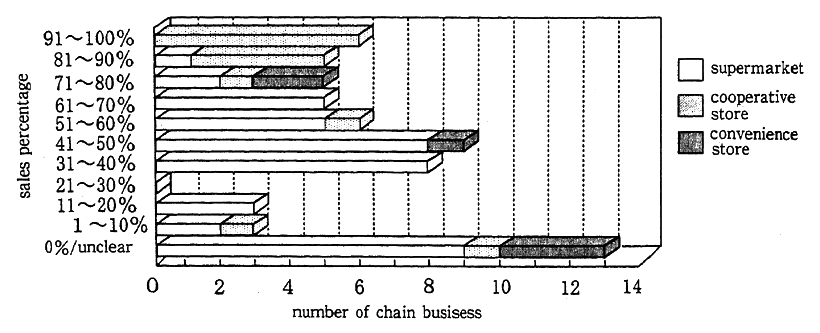
Note Sixty-three chain businesses, etc. cooperated in the survey (supermarkets 43, cooperative stores 14, convenience stores 6)
Source Green Consumer Network "Environmentally Friendly Buying Guide" (December 1992)
This kind of measure from the point of view of consumers, in addition to the consumption aspect, is also being attempted from the point of view of investment in companies. Since this is ,making the social side of a business a standard for decision in investing and carrying out socially responsible investment in stocks and bonds, called a "green portfolio" by citizens' groups, the decision of which company to invest in depends on the state of the company's measures towards environmen-tal problems. In Europe and the United States, socially responsible investing has already started through investment trusts, etc., but mea-sures in Japan have not yet been completed. New attempts concerning the evaluation of companies from the environmental aspects of the degree of information disclosure of environmental problems, the struc-ture of measures, strategic planning and performance, etc. are being considered.
Further, related to these kinds of environmental conservation activities, as can be seen in Germany's eco-bank, experiments are being started to use financing to contribute to environmental conservation by the establishment of voluntary syndicates. Further, the buying of the bonds of private financial organizations for developing countries by international NGOs, and the demanding of expenditures for the protec-tion of nature in place of repayment of the bonds, called a debt environ-ment swap, is also taking place. This is attracting attention as some-thing that can simultaneously bring about the effect of reducing the debt of developing countries and the leverage effect, so that the environmen-tal conservation expenditure amount of developing countries will become 1.1-8.4 times (actual price by December 1993 according to the World Debt Table) the amount offered for investment to buy bonds.
3. Measures of Business and Industry
Measures on the part of business are independently and actively progressing, such as, technology transfer, implementing independent observation of the environment, preparing the system for environmental conservation, deciding on independent action plans related to the envi-ronment and charters for global environmental conservation by busines-ses and economic groups.
(1) Independent measures in environmental management and environmental audits
Amid the worldwide increase in concern about environmental problems, businessmen in companies which are the principal pillars of economic society are increasingly making independent and pro-active environmental efforts, not limited to just observing regulatory stan-dards and laws. An indication of the progress made toward the forma-tion of an environmental management system may be found in Table 4-5-2, according to the "Survey on Corporate Activities Amiable to the Environment," (hereafter referred to as the "Environment Agency Business Action Survey)" conducted by the Environment Agency in 1994 (Of 2,177 companies listed on stock exchanges, 906 (41.6 percent) responded.
The international standardization of an environmental manage-ment system has been studied by the International Organization for Standardization (ISO). The expert committee on the subject, TC207, investigated environmental audits (EA) and environmental management systems (EMS) which have attracted great interest in many countries. An environmental management system's direct objective is to foster improvements in the system itself by: (1) creating policies related to environmental management; (2) creating plans and objectives related to the environment; (3) implementing, operating (improving a system, training of employees, document management) ; (4) inspecting, correct-ing (records, auditing of environmental management systems, etc.); and (5) establishing procedures within organizations for reviewing environ-mental management systems by the executives. Advantages to introduc-ing this kind of environmental management system include, responses to customer expectations regarding the environment, promotion of a good relationship between the public and society, limitations in the scope of responsibility, conservation of energy and invested assets, and cost control. Companies that aggressively carry out these measures may be able to increase their competitiveness vis-a-vis other companies which instead engage in activities in symptomatic treatment manner.
Table 4-5-2 Situation of Developing Environmental Management Systems by Industries
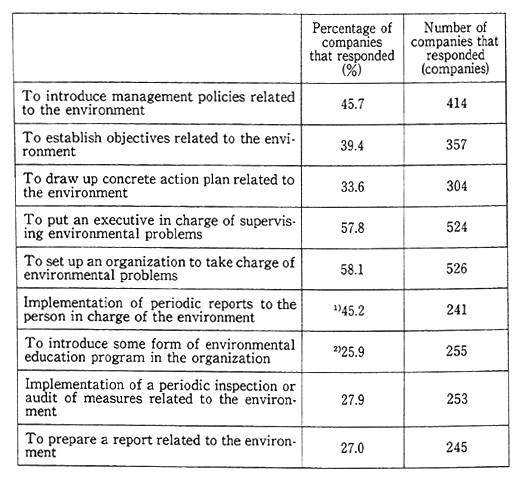
Note The percentage of companies responding is the percentage of the 906 companies that responded to the questionnaire. Depending on the question, 1) is the percentage with respect to the 533 companies that have established organizations to be in charge of environmental problems and those which plan to establish them in 1994, and 2)is the percentage on 983 companies including multiple replies.
Reference Environment Agency
The companies surveyed, regarding international standardization of environmental management systems studied at the ISO, responded with their concerns for the future. According to the Environment Agency Business Action Survey, the greatest number of respondents (35 percent) are "concerned that there is no particular objective" followed by 27.2% "there is great concern, and we are collecting information," 20.2% of "there is great concern, and we are studying what our future objectives will be." Respondents saying "don't know, because we don't know much about the ISO," occupied 15.2%. Of all respondents, 26.4% (153 companies in the manufacturing sector) replied that they were studying what their future objectives will be.
In Japan, in June 1993, the Environmental Management Standard Committee was established under the Japanese Industrial Standards Committee (JISC) affiliated with the ISO. Investigation concerning domestic standards and the way systems should be, and responding to the work of setting standards in the ISO, is progressing actively. Further, independent measures for environmental management are starting, such as, the establishment of the Japanese Environmental Certification Organization (JACO), centered on the electric equipment and electronics industry; the promotion of the responsible care activity by the Japan Chemical Industry Association that independently man-ages the environment and safety of chemical substances and the measures of the Japan Federation of Cooperatives.
Concerning the environmental management of business, it has been ranked as an important pillar that should be promoted as a specific action for environmental conservation in the Basic Environment Plan. As a measure to reduce the burden on the environment, not just one part of the industrial sector, such as the manufacturing industry, but a wide range of business that cause a burden on the environment are able to participate. It is important to promote the further advancement of this trend. Concerning the diffusion of environmental management, in November 1994 a liaison committee of concerned ministries and agencies was established. The Environment Agency is investigating policies to support and promote environmental management desirable for Japan.
(2) LCA, measures of products, etc. contributing to a reduction of the burden on the environment
Regarding business's efforts promoting environmental conserva-tion, study is underway concerning the international standardization of environmental labels and life cycle assessment (LCA) as well. LCA is an evaluation method for objectively grasping a product's burden on the environment, scientifically and quantitatively, as a series of processes from production through consumption, use, and disposal. And its utiliza-tion is something which is intended to reduce the burden on the environ-ment. The environmental loads marked for LCA are ecological influ-ences as carbon dioxide emissions due to energy consumption, air polluting substances emissions, water pollutant discharges, resource consumption and waste discharge, and further, offensive odors and the loss and destruction of forests (Figure 4-5-3).
The basic process of the LCA method is composed of four steps
(1) establishing the basic requisites, such as, defining the problem, objective, scope and unit of the subject, the subject phase (Goal Defini-tion) ; (2) carrying out a detailed data analysis of the substance at each process of the life cycle, energy input and output (Inventory Analysis) (3) analyzing data from the relationship to environmental problems and evaluating the influence of the environmental load (Impact Assess-ment) ; and (4) evaluating the improvement of the environmental load carried out to extract points to change in order to ease the overall environmental load (Improvement assessment).
Fig. 4-5-3 Conceptual Diagram of the Burden on the Environment and Life Cycle
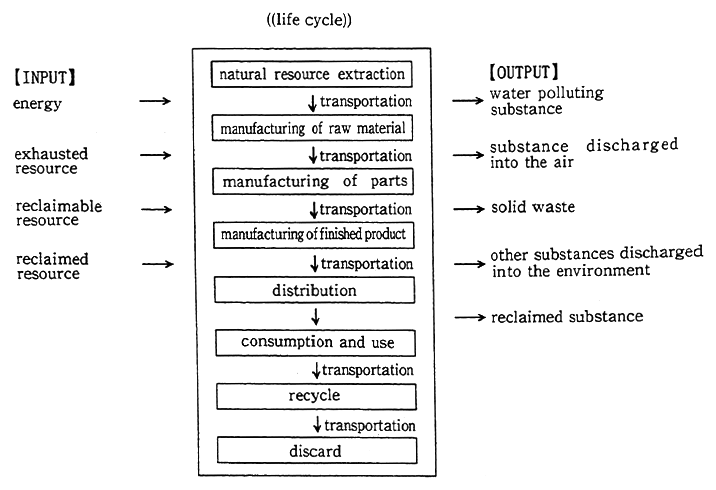
Source Environment Agency
The LCA is considered to be an extremely effective method for reducing the burden of business activity including product development and system development, on the environment, but a definitive LCA method has not yet been established. Study of the general principles is proceeding in the International Organization for Standardization (ISO) concerning LCA standardization. Future questions are increasing confi-dence in the quality of the collected data and whether it is necessary to make possible verification of the individually implemented LCA methods. Further, the diffusion of LCA, besides resulting in the introduc-tion of environmental labels (such as Japan's eco-mark businesses), can also be utilized to improve the environmental quality of products.
(3) Environmental conservation in business and specific measures for reducing the environmental load
In 1994, the Environment Agency conducted a questionnaire survey of the joint measures of all types of businesses (906 in total) in activities that contribute to society, as well as those on a work level, and the group measures of three types of industries distribution, service, transport, communications, financial and insurance businesses (total 226 businesses) ; the construction industry (87 businesses) ; and the manufacturing industry, also including the electricity and gas util ities supplying industries (593 businesses). Specific measures for environ-mental conservation in companies, based on the results of this, are seen below.
i. Measures of the manufacturing as well as the electricity and gas supplying industries
At the technology development and product development stage, businesses that carry out "product development planning to impose a small burden on the environment" were the most numerous at 51.6%. Next were "development and planning to make recycling possible" at 36.1% and "development and planning of products that used recycled resources" at 34.1%. Compared to this, checking products according to a product assessment, such as LCA (14.5%), and lengthening product use, and reinvestigating model changes (16.5%), were not done very often (Figure 4-5-4).
At the level of resource extraction and the purchase of raw materials, 19.9% of the businesses carried out "extraction and the purchase of manufactured raw materials and intermediate goods with sufficient environmental countermeasures," but with "no particular measures taken at the resource extraction and raw material purchasing stages" (45.7%), and "unknown" (23.6%), measures at the resource extraction and raw material purchasing stages can be regarded as having not progressed.
Fig. 4-5-4 Measures of the Manufacturing Industry as well as the Electricity and Gas Supplying Industries (technology development, product development, resource extraction, raw materials purchasing and manufacturing stagees)
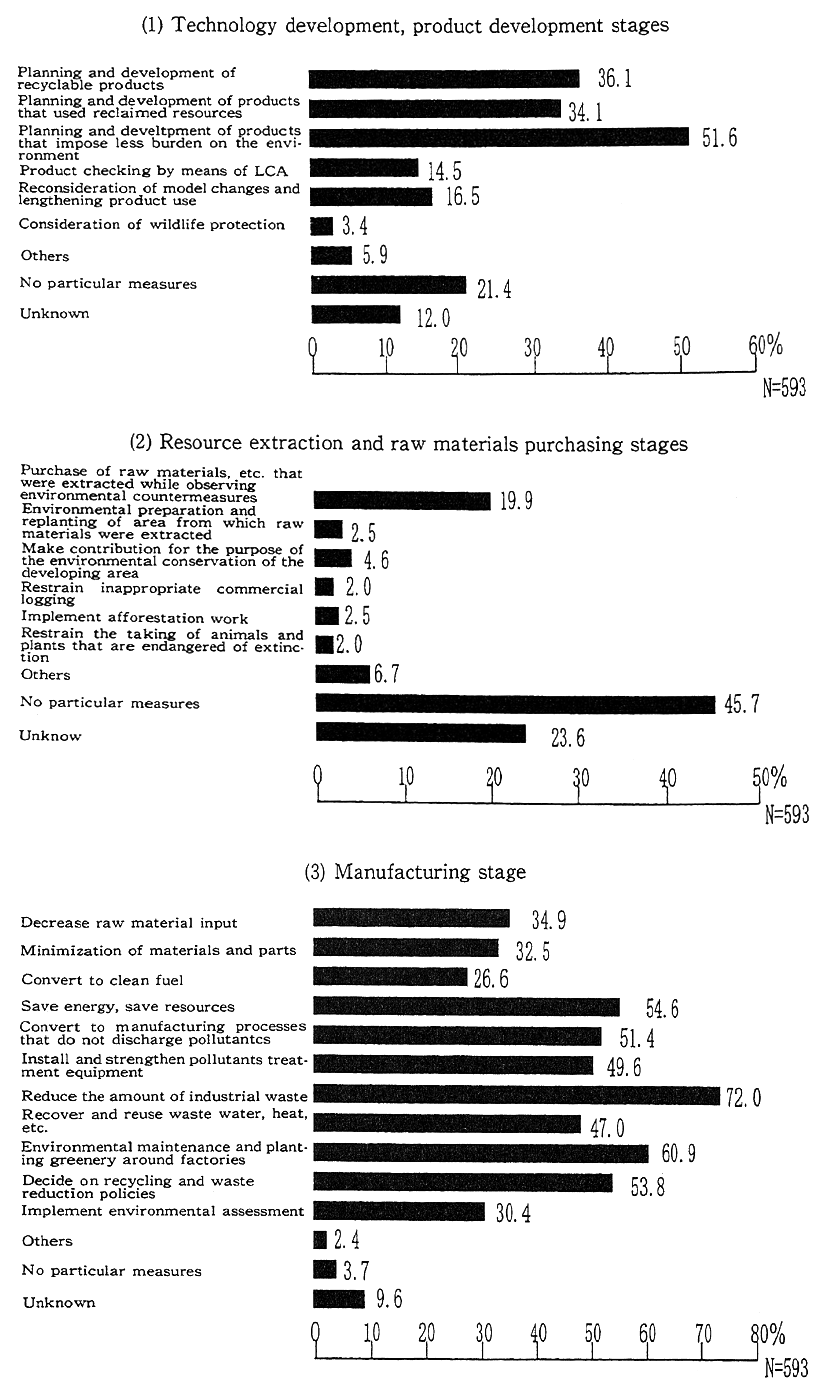
Source Environment Agency
At the manufacturing level, most of the businesses (72.0%) car-ried out "reduction of industrial waste materials." Next, with 60.9% for "industrial afforestation and environmental preparation," and 59.7% for "energy saving and resource saving (implementation of co-generation, area-wide air conditioning, daylight saving time), general measures are making progress. And measures that are starting that contribute to a reduction of the burden on the environment are "shifting to manufactur-ing processes that emit no/few pollutants" (51.4%), "recover and reuse heat and waste water" (47.0%), "reduced the amount of raw materials purchased" (34.9%) and "reduced the parts and materials used in every kind of manufactured product" (32.5%).
At the distribution and sales stage, 48.2% of the companies carried out "reduction of the amount of wrapping and packing." Next, 39.8% carried out measures, such as the "use of wrapping material that imposes a small burden on the environment."
At the disposal stage, 53.5% of companies "introduced disposal management forms (manifest system)." Next, the main measures car-ried out were "recovery and recycling of used container wrapping material" (36.4%) and "recovery and recycling of used manufactured products" (27.5%).